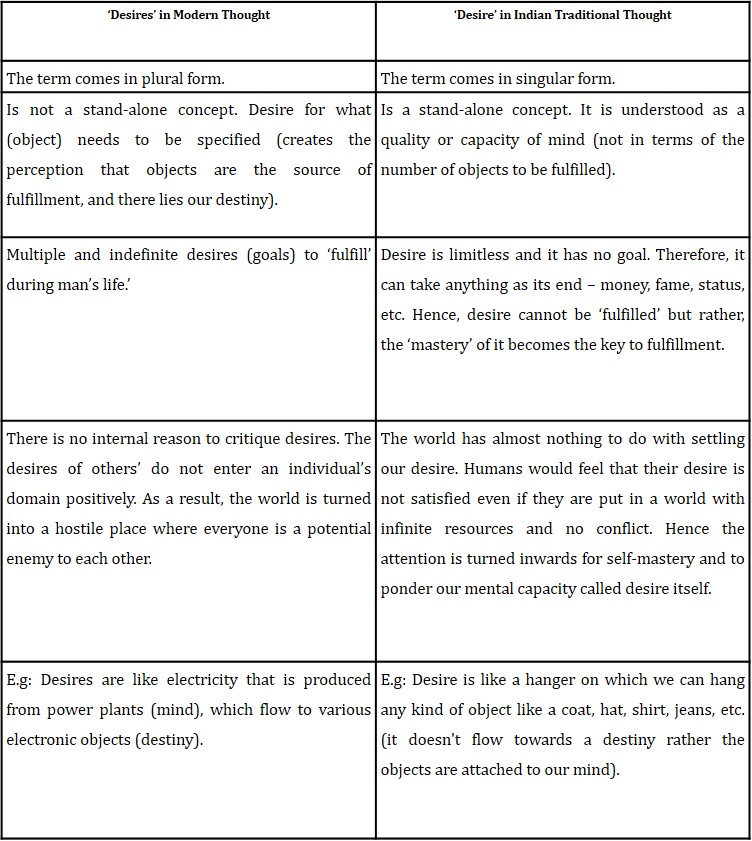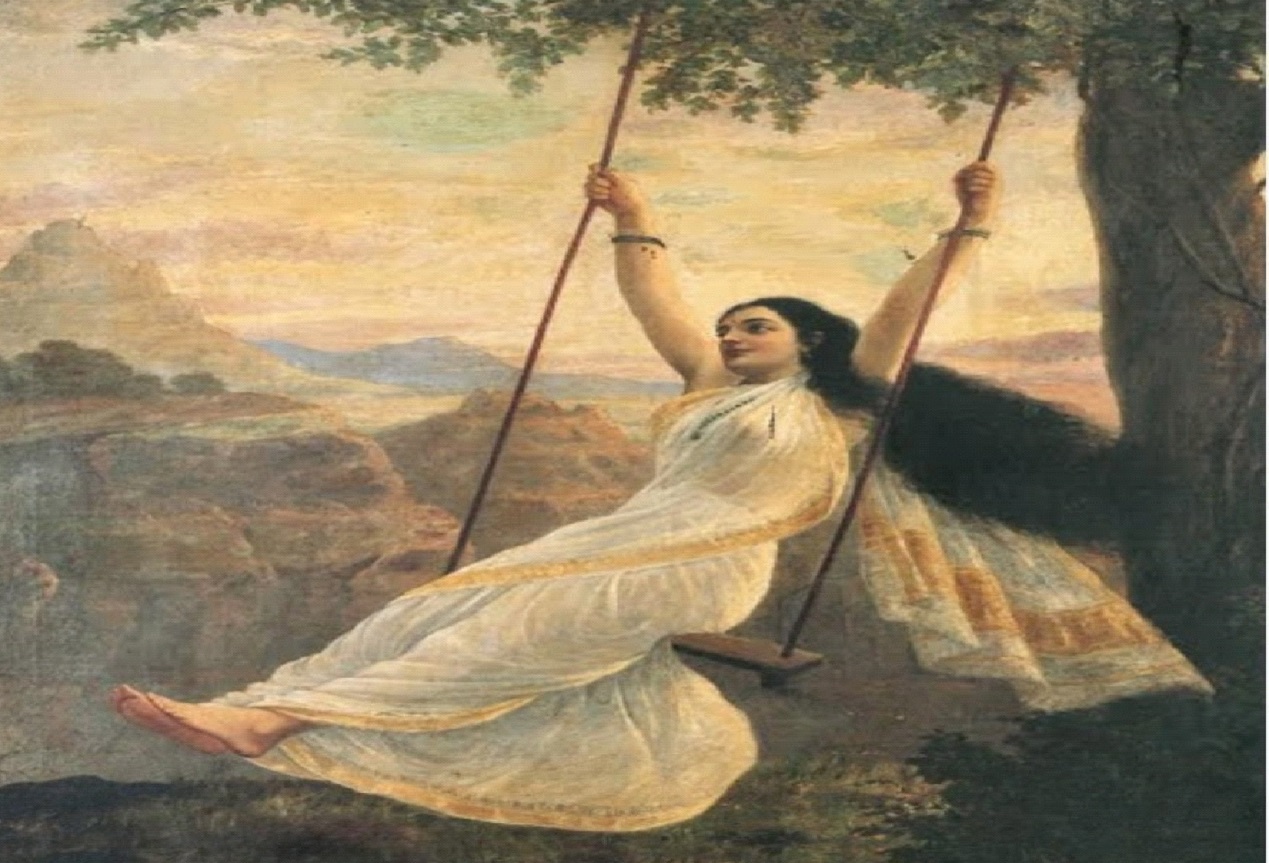To Kāma , who makes the gods Śiva, Brahmā and Viṣṇu
slaves in dark chambers of doe-eyed women;
To Kāma, whose marvelous artifice eludes all words”
Can there be any society, culture, or individual that hasn’t thought about desire, reflected, and pondered over it in one or the other way? Some of us try to forcefully control the desire, while some attempt to fulfill one after the other, yet may feel unfulfilled, and many of us face both these experiences in our life. There could be many views, and methods on how we deal with, work on or manage our desire in life.
Both in the Indian traditions and post-enlightenment modern Western thought, desire(s) comes as one of the major themes of inquiry in understanding the world we experience. It’s quite obvious that there could be differences between the traditional Indian and the modern discourse on desire. But are these differences on the subject of desire, merely based on how one person differs in managing his or her desire from the other? Is it similar to how perceptions on how to deal with desire change from individual to individual, or from tradition to tradition? Even within Indian traditions, we can see how each of them differs in their attitude and method of dealing with desire. Similarly, is the difference between Indian tradition and modernity on the aspect of desire a mere matter of perceptual contrast or difference in opinion?
A perception is established only once there is an underlying agreement between the stakeholders on what they are discussing. Just like there could be different perceptions or reviews about a book, the precondition to doing that would be for all of them to have read the book. Simply put, we must make sure that we are talking about the same thing before we share our perceptions of that particular object. Otherwise, there is always a disproportion in the dialogue, which doesn’t allow the coexistence between these ‘perceptions’ to happen. This is because they are ontological differences masqueraded as different perceptions about the same reality.
What if desire in Indian tradition is not at all the same thing as it means to be in modernity? For instance, the Indian tradition emphasises Kāma as the ‘beginning’ of life, as the seed of creation (Aitareyopaniṣad 1.1.1). On the other hand, modernity emphasises desires as our destiny or as succeeding ‘ends’ of our life. More contrastingly, while Indian tradition sees desire as the root of sorrow, modern cults approach it as a means of fulfilment in life. Desires in modernity as means of ‘fulfilment’ is also an ontological mismatch with how desire or Kāma is presented in Indian traditions as one of the four Puruṣārthas. This article intends to ponder over such conflicts between Indian traditional and modern conceptualisation of desire(s). This article argues that such contrasting approach is not merely a difference in opinion, rather there is some ontological difference in what desire constitutes for Indian tradition and the Modern West. Perhaps, this has led our minds to be in a cross-cultural entanglement, where the modern cognition of desire dominates our experience even as we try to comprehend what desire is in the Indian context as given in the Gītā for example. This is more evident when many of us are unable to understand how desire could be the root of our sorrow and one of the Puruṣārthas at the same time. Such a demonstration also intends to suggest that this issue is not only beyond perceptional difference but also beyond a translational difference between Sanskrit (traditional) and English (modern).
Understanding Desire(s) in Singularity and Plurality
The Indian traditions always speak of ‘desire’ in the singular, while the Modern West speaks of ‘desires’ (in plural). The element of desire and associated concepts like delusion has been personified in many stories that appear in Indian traditions. For instance, Mohinī Devī, an avatar of Nārāyaṇa himself is delusion personified. Likewise, Kāma Deva is a personification of Kāma. Such personifications are possible because Kāma (desire) or Mohā (delusion) is a singular and standalone conception in Indian tradition. These conceptions don’t require an external object to explain themselves. This is in contrast to the Modern Western theories, where the concept is always told in the plural as ‘desires’. This means that the ‘desire’ is not a standalone concept, and without the assistance of an external object, a desire cannot be explained. ‘Desire for what?’ needs to be specified, otherwise ‘I have desire’ sounds like an unfulfilled statement, that requires further explanation. Meanwhile, the Indian tradition speaks of Desire as a quality that is inherent and could be explained and thought about even without the assistance of an object.
In the Western conception of a human being, ‘man’ develops multiple desires during his life; desire for multiple objects like power, fame, money, women, etc. This way, each desire is a goal or destiny of its own to be achieved by a human being in his life. As a result, the world becomes a hostile or an ever-frustrating place to live in, and it would appear like the other person is always hindering us from achieving our desires, rights, freedom, etc. This worldview pretty much makes everybody potential enemies of each other. All the modern revolutionary philosophies from capitalism to communism subscribe to this notion of desires in their political thought. As a result, this explanation of desires has become influential and the normative understanding with regards to modernity. Hence, there is no wonder if one doesn’t find any modern political or economic thought critiquing ‘desire’ in our times. Indeed, there are notions of duties and self-control that touch the ‘controlling’ of desires. But often, the reasons to ‘control’ the self are put out on an external agency, like fear of God (in theology) or the law (in secular thought), and sometimes some desires are controlled or dropped for the sake of achieving other desires (objects). As long as the motive to critique desires is dependent on such external agencies, they do not remain sustainable. In such cases, there is no internal reason that is enduring as to why I ought to respect others' desires. Because of that, an individual is not bounded by the desires others have, and their desires doesn’t enter into our consideration positively (even if that desire is righteous). The hostility is precisely because my desires pick out my capacities and powers without considering anyone else’s desires.
In the words of Svāmi Chinmayananda, “Kama is ‘desire’ for what is absent’ at present in the scheme of our life, and Raga is ‘affection for what one already has’. These are the two emotions, lashed by which, individuals or communities, or societies or nations, generally expresses their might and strength (Balam). Riots and agitations, battles and wars, are all ever motivated by these two dangerous urges.”
If there is an individual, society, or any civilization where a critique on ‘desire’ is absent, isn’t it what could be called Barbarism? What else could be the criteria to call someone barbaric? (Skin colour cannot be). The implications of this thought in modern society, its consequences on our mental health, lifestyle, environment, statecraft, the idea of freedom and rights, etc., could be analysed, which are beyond the scope of this article. Furthermore, to show the historical background in which the ‘Modern West’ ended up in the understanding of ‘Desires’ is also beyond the scope of this discussion.
The Indian traditions on the other hand, which speak about desire in the singular indicate that desire has no goal. Rather, it is a quality in us, a capacity of our mind that could attract endless objects to it from time to time. In Prof. Balu’s simple analogy, “...desire becomes the hanger on which you can hang any kind of coat, shirt, hat, or trousers.” Desire indeed creates objects, but these objects do not create desire by themselves in the Indian understanding of the subject. Hence, Indian traditions do not understand futile objects as the source of our desire, happiness, or worry. By understanding the indeterminacy and limitlessness of desire, the attention is turned inwards for self-mastery and to ponder the mental capacity called desire itself.
The contrast factor here is that while modern thought speaks of ‘Desires’ (objects) as a means to attain fulfillment, the Indian tradition speaks about ‘Desire’ (as a capacity of our mind) that narrows as a result of unfulfillment. Hence, the Indian traditions don’t feel the world is a hostile place, as the world has almost nothing to do with settling our desire. Since Indian traditions consider that even if humans are put in paradise or a world where there are infinite resources and no conflict to satisfy desire, we would continue to feel unsatisfied if we are slaves of our own desire. The more unfulfilled one feels the more their desire gets agitated, which makes them crave for feelings and objects now and then and become their slaves. In that sense, the Indian traditions speak about ‘settling’ their desire through adhyātma rather than trying to ‘fulfill’ them. The rest of the discussions, debates, and practices in Indian traditions, as it is in the Gītā are also about how to attain fulfillment so that our desire does not remain unsettled.
In the discussion above, what we have tried to discuss is not two different approaches or points of view on ‘desire’. Rather, it was to argue that what constitutes desire in Indian and Modern thought are actually two different conceptions altogether, which are not on the same grounds to even share perceptions with each other.
Before moving further, the arguments given in this section are illustrated in the table given below:

Gratifying ‘Desire’ to drop ‘Desires’
In modernity, we are entangled between these two conceptions of desire, which are not on equal grounds. This cross-cultural entanglement not only obstructs us from gaining clarity on the subject but also leads us to a misapprehension of the Indian traditional discourse on desire.
It’s perhaps true that the understanding of desires (in plural) as a means of fulfillment through objects dominates our cognition. Thus, when in a lecture on the Gītā, we listen to the point to ‘drop’ our desires, we get confused. Even though the Gītā talks about ‘desire’, in the singular form as mentioned earlier, on the receiving end, we listen to it as ‘desires’ (in terms of objects). As a result of this confusion, a few questions come up, like without desire (objects) how do we live? When the Gītā says drop attachment, we tend to question how can we selfishly ‘drop’ those good people from our life? We feel like the Gītā is guiding us insanely to drop the objects desired immediately. We tend to assume that the Gītā is talking about an ‘ideal’ life, which is ‘other worldly’ and may be difficult to practice in our daily life, especially in today’s fast-paced lifestyle. These questions are not invalid, they are not to be discarded, rather what is to be understood is that these strong questions are emerging from our preconceived normative notions on ‘desires’ as populated through modernity. Once we understand how it is distinct from what constitutes desire in texts like the Gītā these questions might get dissolved on their own.
In the modern discourse where desires are directed towards objects, there is a weightage given to these objects. So much so that, in life we tend to perceive as though our source of happiness or sorrow lies in these objects. Whereas, in a way, the Indian traditional view considers this human-object relationship in reverse order. These objects are futile, our engagement with them does agitate our ‘desire’ but the source of our happiness and sorrow doesn't rely on them. Hence, they do not happen to understand the objects or desires as our destiny in life. Rather, texts such as the Gītā tell us that such an attached attitude towards objects would lead us to desire-anger-delusion-loss of memory, destruction of discrimination and finally self-deterioration (popularly called the ‘ladder of fall’, see Gītā 2.62-63).
Svāmi Chinmayananda Saraswati once gave a simple equation to understand happiness. He said:
Happiness = Number of Desires Fulfilled ÷ Number of Desires Entertained
Though Svāmiji is using the term ‘desires’ in the plural form, his general approach was characterised by an appeal mainly to the English educated, following which he expressed that, while Indian Rishis focussed on reducing the denominator, the Modern world tries to increase the numerator. How is it that the Indian Rishis try to decrease the denominator (no. of desires entertained)? Just by escaping from the objects, can one become ‘desireless’? If that is the understanding, then it rightly sounds more like an impractical exercise at any time. Here is where understanding ‘desire’ as a stand-alone concept (not in terms of objects) becomes significant. Let us have the privilege to quote Svāmi Chinmayananda himself to gain clarity over this while explaining the Gītā 2.55:
“..An intellect, contaminated by ignorance becomes the breeding ground of desires, and he who has relieved himself of this ‘ignorance’ through ‘right knowledge’ gained by right perception, naturally, becomes ‘desireless’..” (Emphasis added).
Therefore, what is being suggested here is that desire comes out of a sense of unfulfillment, due to a lack of knowledge. The Gītā gives us guidance on how to naturally get fulfilled so that a new desire doesn’t arise. Here, neither does it promise that desires or objects fulfill us like modern edible culture assumes nor does it claim that abstaining or escaping from objects would make us ‘desireless’ (Gītā 3.4 - 3.6). That being said, the practice of abstaining from objects is very much a method in Indian tradition to gratify ‘desire’ to become ‘desireless’. But the decision of an adult to practice abstinence, at least temporarily, like a Vṛta comes from a knowledge, which naturally drives a person to attach an amount of value to the act of renunciation (For an instance, See Manusmṛti V. 56).
Svāmīji goes on to explain, “In one’s ignorance when one conceives of oneself as the ego, one has a burning desire for sense objects…. The ‘Man of steady Wisdom’ (Sthitaprajña), satisfied in the self, can no longer entertain any desire (naturally) or have any appetite for the paltry objects of the body, mind, or intellect. He becomes the very source of all Bliss” (emphasis added).
It is not that pleasure is ‘sinful’, but at first, it's insatiable, and second, the subjectivity of a false human ‘ego’, the assumption that ‘I’ am the enjoyer, and the world is withdrawing it from me leads us to an incurable dissatisfaction. Whereas, when a person of steady wisdom (Sthitaprajña) even when s/he manages to engage with the objects with less ego and attachment, experiences a constant bliss. That blissful state makes the ‘desire’ or Kāma satisfied and naturally, no other ‘desires/objects’ pops up in their mind as craving. Hence, between the spectrum of pleasure and bliss, lies our ego. In life, as we lead towards a less ego-centric living (possible through Jñāna), we get closer to the bliss, which itself would gratify our desire, the Gītā suggests. This is why desire for Mokṣa, isn’t harmful or doesn’t bring sorrow, as the pursuit is selfless. Because in its journey, there is a constant diminishing of ego, of ‘I’ being the enjoyer. Here the ‘desire’ is not ego-centric and it strives to increase its own capacity to uphold Kāma beyond the mundane, time-bounded mortal realities of life.
It is in this sense that ‘desire’ in Indian discourse is spoken in the singular form as a stand-alone concept. To gain clarity over this is quite important for us to unlearn the modern notion of desires, which have gained currency and influenced our thinking. Once this task is being cleared, as we revisit the Indian discourse of desire, we may find desire as a quality, as the capacity of our mind as illustrated above. As Svāmi Chinmayananda puts it, “Desire means a capacity of the mind to see ahead of itself a scheme or a pattern in which he who desires will probably be happier.” As this capacity of mind called ‘Desire’ (Kāma) gets broader, we shed our ego and gain a blissful experience. As this capacity of mind gets narrow, we tend to put our ego of being the enjoyer in front and get attached to the object, resulting in sorrow. As this capacity of the mind gets broader, less egotistical, through Dharma, the desire gets gratified and hence, Kāma is also one of the Puruṣārthas. The four Puruṣārthas are considered as universal needs for fulfillment of any individual as per Dharmaśāstra, gratifying the first three (Dharma, Artha and Kāma ) prepares one to attain Mokṣa. These Puruṣārthas are not watertight compartments, they are interrelated and bounded to each other. Therefore, Bhagavān Śri Kṛṣṇa proclaims in the Gītā that “I am the desire unopposed to Dharma” (Gītā 7.11). Thus, as mentioned above, by gratifying ‘desire’ through Dharma, one gets into the path of detachment.
Conclusion
This article attempted to illustrate the reason for our popular misapprehension of what is ‘desire’ as discussed in Indian tradition. This arises out of a delusion created by modern thoughts, which gives us a preconceived notion of desires as a means of fulfillment. This situation puts us in a delusion (Mohā) that swings between the Modern and Indian traditional conceptualisation of ‘desire’. To unpack this, the article differentiates the Western and Indian discourse of desire, as the former explains the term in the plural form and the latter in the singular form. This differentiation was followed by an explanation of what it signifies, especially by taking quotations from Svāmi Chinmayananda’s commentary on the Gītā. These references are used to juxtapose the Indian conception of ‘desire’ against the modern conception of ‘desires’.
Such a juxtaposition perhaps helps us to gain clarity over what ‘desire’ is. Nothing adds to clarity more than confusion, as it is not a wrong perception that stays rigid. A genuinely confused state of mind is flexible and open to knowledge and in reality, confusion functions as fuel to seek clarity. Just like we say, Māyā hinders us from reality, at the same time it is also the upādi or medium for Adhyātma. Likewise, the delusion (Mohā) personified by Goddess Mohinī and desire (kāma) personified by God Madana often puts us on a test to lead us through unreal to the real, through the darkness to the light.
(The paper is the author’s individual scholastic articulation. The author certifies that the article/paper is original in content, unpublished and it has not been submitted for publication/web upload elsewhere, and that the facts and figures quoted are duly referenced, as needed, and are believed to be correct). (The paper does not necessarily represent the organisational stance... More >>
Image Source: https://artsandculture.google.com/asset/mohini-or-the-temptress-ravi-varma-press/OgG-MH0lE9tonQ?hl=en&ms=%7B%22x%22%3A0.5%2C%22y%22%3A0.5%2C%22z%22%3A8.45582899628598%2C%22size%22%3A%7B%22width%22%3A3.6975334559823088%2C%22height%22%3A1.2374999999999998%7D%7D











Post new comment